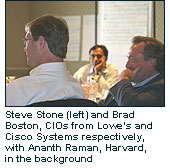
|
|
|
 |
|
 |
Elusive Integration:
Making the Link between Sales and Operations Planning Thought Leadership Summit on Digital Strategies February 17, 2004 - Dallas, TX hosted by Cisco Systems
|
||
|
Press Release
Agenda
List of Participants
Discussion Guide
Overview Article
|
|||||
Integrating the forward and backward facing processes within supply chains, focusing on the link between demand forecasting and supply chain implementation, was the topic of the sixth Thought Leadership Summit on Digital Strategies, hosted by Cisco Systems, Inc. in Dallas. CIOs and other senior executives from a number of Fortune 250 companies including 3M, Cargill, Cisco Systems, GM, Lowe's, Owens Corning, Staples, Sysco and Whirlpool participated in this roundtable forum, together with a select group of senior academics specializing in the subject matter, yielding the following insights:
- The perennial issues of aligning sales and operations planning (S&OP) are being exacerbated by a new set of trends such as:
- Shrinking product life cycles - traditional, slower-moving products are becoming seasonal, fashion-focused, or both;
- Global sourcing - long lead-times coupled with short product life makes forecast accuracy ever more important.
- Getting the S&OP language straight is more important than you think - and surprisingly more difficult to manage internally than externally. The sales language is often not that of operations. When you extend outside the enterprise, you expect to have to work at communicating, internally you do not.
- Avoid the trap of a single number - forecasts should always include some measure of uncertainty. Scenario planning for various contingencies can greatly enhance flexibility and response times when the unusual happens. Developing a well understood metric that can be visually communicated is the key to internalizing forecast uncertainty into the planning process.
- Trust is the key to making extended inter-enterprise S&OP work. The way to achieve that trust in a sustainable way is by partnering with those companies whose self-interest is most closely aligned with yours and who share common drivers and a common culture. Every relationship should be reevaluated periodically.
- Information technology makes unobservable things observable - IT can enable or even induce incentive alignment and trust through visibility.
- There is an increasing need for contract frameworks that can accommodate win-win S&OP arrangements between value chain partners.
This roundtable was moderated by Dave Margulius of Enterprise Insight with some help from the center's executive director, Hans Brechbühl, on the breakouts. The summit was hosted by Cisco Systems at the beautiful Four Seasons Resort and Club Dallas at Las Colinas. Mike Gozycki, one of the center's MBA Fellows joined the group for the day.
![]()
| To link to the Thought Leadership Summit on Digital Strategies website, click here. |